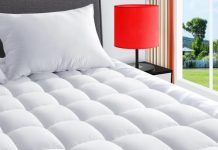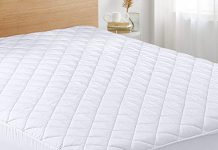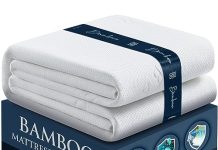Looking to add a touch of softness to your firm mattress? Look no further! In this article, we explore the wonders of mattress toppers and their ability to transform your sleep experience. Discover the secrets behind how a humble mattress topper can turn even the firmest mattress into a plush oasis of comfort. Say goodbye to restless nights and hello to a rejuvenating sleep with just a simple addition. Read on to uncover the key to a softer, more luxurious slumber!
Review contents
Understanding Mattress Toppers
What is a mattress topper?
A mattress topper is a removable layer of padding that is placed on top of a mattress to provide additional comfort and support. It is usually made of a variety of materials such as memory foam, latex, wool, or down alternative. Mattress toppers are available in different thicknesses and densities, allowing users to customize their sleeping experience based on their personal preferences.
Types of mattress toppers
There are several types of mattress toppers available in the market. Memory foam toppers are popular for their ability to conform to the body’s shape, relieving pressure points and providing excellent support. Latex toppers, on the other hand, are known for their durability and responsiveness. Other types of toppers include wool, down alternative, and feather toppers, each offering their unique benefits and characteristics.
Common materials used in mattress toppers
Mattress toppers can be made from a variety of materials, each with its own set of advantages and disadvantages. Memory foam toppers, for instance, are highly popular due to their ability to contour to the body and relieve pressure points. Latex toppers, on the other hand, are known for their resilience and durability. Wool toppers offer excellent temperature regulation and moisture-wicking properties, while down alternative toppers provide a soft and fluffy texture. Understanding the different materials can help determine which type of mattress topper is most suitable for individual needs.
The Role of a Mattress Topper
Enhancing comfort
One of the primary roles of a mattress topper is to enhance the overall comfort of a mattress. If a mattress feels too firm, adding a mattress topper can provide a softer sleeping surface. The extra layer of padding can help alleviate pressure points and create a more plush and cozy feeling, contributing to a more restful sleep experience.
Providing additional support
In addition to comfort, a mattress topper can provide additional support to the body while sleeping. Some toppers are specifically designed to contour to the body’s shape, distributing weight evenly and reducing strain on pressure points such as the shoulders, hips, and lower back. This added support can help improve spinal alignment and alleviate discomfort, especially for individuals with back pain or joint problems.
Prolonging mattress lifespan
A mattress topper can also play a role in prolonging the lifespan of a mattress. By acting as a protective layer, it can help prevent wear and tear caused by daily use. The topper absorbs some of the body’s weight and impact, reducing stress on the mattress itself. Consequently, the mattress may experience less sagging and indentations, preserving its structural integrity and contributing to its longevity.
Factors to Consider When Choosing a Mattress Topper
Thickness
The thickness of a mattress topper is an important factor to consider when selecting the right one. Thicker toppers generally offer more cushioning and can effectively soften a firm mattress. However, it is essential to strike a balance as an excessively thick topper may make the bed too soft and result in a lack of support.
Density
Density refers to the weight and compactness of the materials used in the topper. Higher-density toppers tend to be firmer and more supportive, while lower-density toppers offer a softer feel. The choice of density depends on personal preference and the desired level of comfort and support.
Material
The choice of material is crucial when selecting a mattress topper. Memory foam and latex toppers are known for their contouring and pressure-relieving properties, while wool toppers provide excellent temperature regulation. Consider allergies and sensitivities when choosing materials, as some individuals may be sensitive to certain fabrics or have respiratory issues.
Temperature regulation
Temperature regulation is an important consideration, especially for individuals who tend to sleep hot or cold. Some toppers are designed with cooling properties, such as gel-infused memory foam or breathable materials, to help dissipate heat and maintain a comfortable sleeping temperature. Conversely, wool toppers offer natural insulation and can help keep individuals warm during colder months.
Allergies and sensitivities
For individuals with allergies or sensitivities, it is crucial to choose a mattress topper that is hypoallergenic and free from potential irritants. Some toppers are made with natural materials that are resistant to allergens and dust mites, making them a suitable choice for those with respiratory conditions or allergies.
How Does a Mattress Topper Make a Firm Mattress Softer?
Padding and cushioning
A mattress topper adds an extra layer of padding and cushioning to a firm mattress, effectively softening its surface. The additional padding helps alleviate the discomfort often associated with sleeping on a too-firm surface, creating a more comfortable and inviting bed.
Pressure relief
One of the ways a mattress topper makes a firm mattress softer is by providing pressure relief. A firm mattress can create excessive pressure on certain areas of the body, leading to discomfort and poor sleep quality. A mattress topper, particularly one made of memory foam or latex, can contour to the body’s shape and distribute weight more evenly, reducing pressure points and promoting better circulation.
Body contouring
Mattress toppers made of memory foam or latex are designed to contour to the body’s unique curves and contours. This contouring ability allows the topper to conform to the sleeper’s body, relieving pressure points and providing customized support. By creating a more personalized sleep surface, the topper makes a firm mattress feel softer and more comfortable.
Motion isolation
Another benefit of using a mattress topper is its ability to isolate motion. If sharing a bed with a partner who frequently moves or tosses and turns during the night, a firm mattress can transmit these motions, causing disturbance and interrupted sleep. A mattress topper, especially one made of memory foam, can absorb and minimize motion transfer, providing a more peaceful and undisturbed sleep environment.
Eliminating pressure points
A firm mattress can create pressure points, particularly on sensitive areas such as the shoulders, hips, and knees. These pressure points can lead to discomfort and pain, potentially affecting sleep quality. By adding a mattress topper, these pressure points can be alleviated as the topper conforms to the body’s shape and redistributes weight, reducing pain and promoting a more comfortable sleep experience.
Adjusting firmness levels
One of the most significant benefits of using a mattress topper is the ability to adjust the firmness level of a mattress. By selecting a topper with the desired thickness and density, individuals can effectively change the feel of a mattress to cater to their specific comfort preferences. This customization allows for a more personalized sleeping experience and ensures maximum comfort throughout the night.
Benefits of Using a Mattress Topper to Make a Firm Mattress Softer
Improved sleep quality
Adding a mattress topper to a firm mattress can significantly improve sleep quality. The extra layer of cushioning and support provided by the topper enhances comfort, reduces pressure points, and promotes better spinal alignment. With improved sleep quality, individuals may experience fewer sleep disturbances and wake up feeling refreshed and rejuvenated.
Reduced pain and discomfort
A firm mattress can sometimes exacerbate existing pain or discomfort, particularly for individuals with back problems or joint issues. By using a mattress topper to soften the surface, the pressure on sensitive areas is reduced, resulting in improved pain relief and enhanced comfort. The added support and cushioning provided by the topper can help alleviate aches and pains, leading to a more comfortable sleep experience.
Cost-effectiveness
Purchasing a new mattress can be a significant investment. However, using a mattress topper to make a firm mattress softer provides a cost-effective alternative. Instead of investing in a new mattress, which can be expensive, a mattress topper offers a more budget-friendly option while still improving comfort and support.
Versatility and customization
One of the key advantages of using a mattress topper is its versatility and customizability. Unlike permanently altering a mattress, adding a topper allows individuals to adjust the firmness level and overall feel according to their preferences. Whether desiring a plusher surface or a firmer one, a mattress topper provides the flexibility to cater to individual needs and ensures a comfortable sleep environment.
Drawbacks of Using a Mattress Topper
Potential heat retention
Some mattress toppers, particularly those made of memory foam, can retain heat. This may be uncomfortable for individuals who are prone to sleeping hot or in warmer climates. However, many modern mattress toppers are designed with cooling features to counteract heat retention and provide a more comfortable sleep experience.
Possible change in mattress height
Adding a mattress topper can increase the overall height of a mattress. While this may not be an issue for most individuals, it is worth considering if bedding or bed frames have specific size limitations. It is essential to measure the height of the mattress and topper to ensure compatibility with existing bedding and furniture.
Limited effectiveness for severely firm mattresses
While a mattress topper can soften a firm mattress, it may have limited effectiveness for mattresses that are excessively firm. If a mattress is extremely uncomfortable or provides inadequate support, it may be more beneficial to consider purchasing a new mattress instead of relying solely on a topper. It is essential to assess the current condition and firmness level of the mattress before deciding on the best course of action.
Steps to Properly Install a Mattress Topper
Clean and prepare the mattress
Before installing a mattress topper, it is crucial to clean and prepare the mattress surface. Ensure that the mattress is free from dust, debris, and stains. Vacuuming or spot cleaning can help remove any dirt or particles that may affect the topper’s performance. Allow the mattress to fully dry before proceeding to the next step.
Unpack and unfold the topper
Once the mattress is adequately prepared, carefully unpack the mattress topper and unfold it according to the manufacturer’s instructions. Take caution not to damage the topper during this process, as any tears or holes can affect its functionality and longevity.
Align and secure the topper
Align the mattress topper with the mattress, ensuring it is centered and adequately covering the sleeping surface. Some toppers come with straps or elastic bands to secure them in place, especially if they tend to shift or slide. Attach these straps or bands according to the manufacturer’s instructions to prevent the topper from moving during sleep.
Cover the topper with a fitted sheet
To protect the mattress topper and keep it in place, cover it with a fitted sheet specifically designed for its size. This will help maintain hygiene, prevent any buildup of dirt or dust, and ensure a snug fit. Additionally, the fitted sheet will help secure the topper onto the mattress, preventing it from shifting or sliding throughout the night.
Additional Tips for Choosing and Using a Mattress Topper
Consider your specific needs
When selecting a mattress topper, consider your specific needs and preferences. Determine the level of firmness or softness desired, as well as any specific features such as temperature regulation or allergen resistance. Research different types of mattress toppers and read customer reviews to gain insights into their performance and suitability for your needs.
Check mattress and topper compatibility
Before purchasing a mattress topper, ensure that it is compatible with your existing mattress. Consider the thickness and size of both the topper and mattress to ensure a proper fit. Incompatibility may result in poor performance, uncomfortable sleeping conditions, or difficulties in securing the topper onto the mattress.
Proper maintenance and care
To ensure the durability and longevity of a mattress topper, practice proper maintenance and care. Follow the manufacturer’s instructions regarding cleaning and maintenance methods. Regularly vacuum or spot clean the topper to remove any dirt or dust, and avoid exposing it to excessive moisture or harsh cleaning agents.
Regularly rotate or flip the topper
To prevent uneven wear and prolong the lifespan of a mattress topper, regularly rotate or flip it. This helps distribute weight and pressure more evenly, avoiding excessive compression in specific areas. Follow the manufacturer’s guidelines on rotation and flipping frequency to ensure optimal performance.
Conclusion
A mattress topper can be a valuable addition to enhance the comfort, support, and lifespan of a firm mattress. By adding an extra layer of padding and cushioning, a mattress topper softens the surface, providing a more inviting and comfortable sleep environment. It can alleviate pressure points, reduce pain and discomfort, and improve sleep quality, contributing to an overall better sleeping experience. However, it is essential to consider factors such as thickness, density, material, temperature regulation, and personal preferences when selecting a mattress topper. With proper installation, maintenance, and care, a mattress topper can offer the benefits of a softer mattress without the need for investing in a new bed.



























